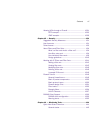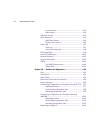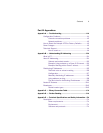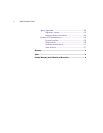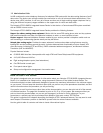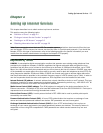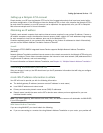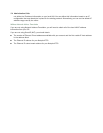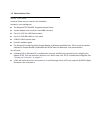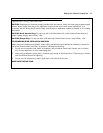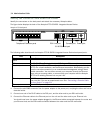
Setting Up Internet Services 2-1
CC
CC
hh
hh
aa
aa
pp
pp
tt
tt
ee
ee
rr
rr
22
22
SS
SS
ee
ee
tt
tt
tt
tt
ii
ii
nn
nn
gg
gg
UU
UU
pp
pp
II
II
nn
nn
tt
tt
ee
ee
rr
rr
nn
nn
ee
ee
tt
tt
SS
SS
ee
ee
rr
rr
vv
vv
ii
ii
cc
cc
ee
ee
ss
ss
This chapter describes how to obtain and set up Internet services.
This section covers the following topics:
■
“Definition of Terms” on page 2-1
■
“Finding an Internet Service Provider” on page 2-2
■
“Deciding on an ISP Account” on page 2-2
■
“Obtaining Information from the ISP” on page 2-3
Note:
Some companies act as their own ISP. For example, some organizations have branch offices that can
use the Netopia 4753 to access the Internet via the main office in a point-to-point scenario. If you install the
Netopia 4753 in this type of environment, refer to the following sections for specific information you must
receive from the network administrator to configure the Netopia 4753 properly.
DD
DD
ee
ee
ff
ff
ii
ii
nn
nn
ii
ii
tt
tt
ii
ii
oo
oo
nn
nn
oo
oo
ff
ff
TT
TT
ee
ee
rr
rr
mm
mm
ss
ss
G.SHDSL.
A rate-adaptive digital communication medium that operates over existing analog telephone lines
provided by the telephone company. G.SHDSL negotiates the highest achievable data rate given the loop
conditions and will allow you to connect to the Internet at a minimum of 128Kbps bi-directional, up to 2.320
Mbps. Your LAN will constantly be connected and you will not have to dial into the Internet. G.SHDSL uses more
of the bandwidth on copper phone lines than what is currently used for plain old telephone service (POTS). By
using frequencies between 26 kHz and 1MHz, G.SHDSL can encode more data to achieve higher data rates
than would otherwise be possible in the restricted frequency range of a POTS network (up to 4 kHz). In order to
use the frequencies above the voice audio spectrum, DSL equipment must be installed on both ends.
Internet Protocol (IP) address.
A network address that uniquely identifies a device on an IP network. This type
of address consists of 4 bytes, represented as decimal values, separated by periods, e.g., 192.168.2.143. All
IP addresses of the form 192.168.1.xxx are private IP addresses.
Media Access Control (MAC) address.
This 48 bit address is assigned by the device manufacturer for its
Ethernet connection. All Netopia 4753 units have MAC addresses of the form 00-C5-9X-XX-XX-XX. Each byte is
represented as a conventional two digit hexadecimal number.
Point-to-Point Protocol (PPP).
A serial protocol defined in RFC 1661 that is used to provide point-to-point
connectivity over serial links.
Password Authentication Protocol (PAP).
A form of PPP authentication that requires an exchange of user
names and clear-text passwords between two devices. PAP passwords are sent unencrypted.
Challenge Handshake Authentication Protocol (CHAP).
A form of PPP authentication that requires an
exchange of user names and secrets (encrypted passwords) between two devices. This security feature is
supported on lines using PPP encapsulation. CHAP passwords are called secrets because they are sent
encrypted.



